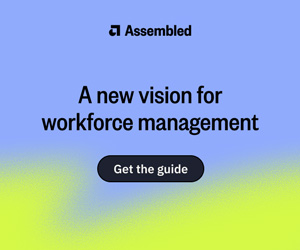In this article contributed by John O’Hara at NICE, he explores why digital may be stressing your agents out.
The overnight shift to working from home created new challenges related to staffing (who is working and when) and agent performance (how they’re working).
But the transition to work from home was only part of the challenge—companies also had to adapt to the rapid adoption of digital channels, which have forced organizations to rethink how they manage agent key metrics and new technology while helping employees balance evolving demands.
COVID-19 fast-forwarded the digital revolution: McKinsey estimates that digital channel adoption jumped ahead five years in the first eight weeks of the pandemic alone. That changed the playing field for contact centres due to the unique characteristics of digital channels, which can be:
- Asynchronous: With digital interactions, there are often significant gaps between the customer’s and the agent’s communications. Consider, for example, a customer who sends an email then heads out of the office for lunch or for a long weekend. Even if the agent responds promptly with a request for more information or a clarifying question, it could be a few hours—or days even—before the customer replies. The agent involved in the conversation may change as a result, and the interaction itself can move from one channel to another (for example, from phone to email or from chat to a voice call).
- Immediate or deferred: Agents now handle both immediate response contacts, like phone and chat, and deferred response contacts, like email. This increases the complexity of the job they’re being asked to do.
- Interruptible: If your contact centre gives priority to one channel over another, for example by asking agents to handle immediate response channels before deferred ones, you’re not alone. When one interaction can be interrupted in favour of another, contact centres must decide whether (and when) one chat or channel should take precedence and how to handle interactions that move from one channel to another.
- Simultaneous: Many contact centres now ask agents to interact with more than one customer at a time—for example, texting with one person while chatting with another and keeping tabs on social media.
As the number of channels increases (as do the complex skill set requirements and elevated customer expectations that accompany them), there’s growing concern in the market about employee cognitive load—how much work we can rationally ask an agent to handle at any given time.
The demands of contact switching due to interruptions and simultaneous interactions on digital channels add to employees’ cognitive load, or individual employees’ abilities to juggle contacts and responsibilities.
Cognitive load is nothing new; it likely had an effect on your agents’ productivity long before COVID-19, but the rapid acceleration of digital adoption in the contact centre has pushed the issue to the forefront. In fact, as Joseph Freed argued in Forbes, cognitive load may be “the most important employee experience metric in the next 10 years.”
Cognitive load matters because overload can lead to frustration and poor decision-making. Generally speaking, the more you throw at an employee, the harder they will find it to switch between channels and conversations.
Even though an employee can handle work up to a certain level in theory, quality takes a hit, and you start seeing diminishing returns in terms of efficiency and the ability to make good decisions. In fact, research reported in Harvard Business Review found that switching from one type of task to another makes it difficult to tune out distractions and reduces productivity by as much as 40%.
Cognitive load also has a significant impact on employees’ overall well-being. When agents hit their maximum cognitive load at work, the effects spill over into their personal lives, increasing stress and anxiety.
How to Mitigate the Effects of Digital Channel Overload
Organizations can help manage cognitive load in a few key ways:
- Set load per type of contact. Video chats, for example, have a higher impact on cognitive load than other forms of interactions due to the extra effort required to send and interpret nonverbal cues, Stanford researchers found.
- Track employee load-based performance data and consider whether the metrics you have used in the past are the right metrics to measure performance in the new, digital world.
- Establish a maximum capacity per employee (both in terms of overall total and per type of contact) and make cognitive load limit adjustments to individual employee contribution. A one-size-fits-all approach won’t work here, because each employee is unique in their ability to juggle interactions.
- Leverage tools with algorithms that ensure that “low” loads do not take precedence over “high” loads, that dynamically define load per type of contact and that automatically adjust employee capacity as needed.
- Adjust base staffing requirements and optimize schedules as required.
- Combat employee disengagement with virtual forms of gamification and additional huddle/coaching sessions.
Digital channels are here to stay, which makes cognitive load an issue you can’t afford to ignore. Digital channels offer significant potential to better—and often more cost-effectively—serve customers’ needs, but maximizing that potential requires doing things differently.

John O’Hara
Contact centre leaders need to understand how common workforce processes and the employee experience alike are affected by the unique characteristics of digital channels—and maximize all of the tools and technology at their disposal to not only handle new demands on staffing and performance management but also keep the agent’s needs front and centre.
Thanks to John O’Hara at NICE for this contributed article.
For more information about NiCE-ltd - visit the NiCE-ltd Website
Call Centre Helper is not responsible for the content of these guest blog posts. The opinions expressed in this article are those of the author, and do not necessarily reflect those of Call Centre Helper.
Author: NiCE-ltd
Published On: 1st Oct 2021 - Last modified: 5th Oct 2021
Read more about - Guest Blogs, NiCE






 NiCE (NASDAQ: NICE) is transforming the world with AI that puts people first. Our purpose-built AI-powered platforms automate engagements into proactive, safe, intelligent actions, empowering individuals and organizations to innovate and act, from interaction to resolution. Trusted by organizations throughout 150+ countries worldwide, NiCE’s platforms are widely adopted across industries connecting people, systems, and workflows to work smarter at scale, elevating performance across the organization, delivering proven measurable outcomes.
NiCE (NASDAQ: NICE) is transforming the world with AI that puts people first. Our purpose-built AI-powered platforms automate engagements into proactive, safe, intelligent actions, empowering individuals and organizations to innovate and act, from interaction to resolution. Trusted by organizations throughout 150+ countries worldwide, NiCE’s platforms are widely adopted across industries connecting people, systems, and workflows to work smarter at scale, elevating performance across the organization, delivering proven measurable outcomes. 






























